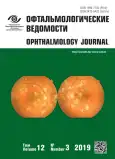脉 络膜视网膜病变误诊的原因之一——局灶性钙化
- 作者: Stoyukhina A.S.1
-
隶属关系:
- Research Institute of Eye Diseases
- 期: 卷 12, 编号 3 (2019)
- 页面: 31-39
- 栏目: Original study articles
- URL: https://journal-vniispk.ru/ov/article/view/15931
- DOI: https://doi.org/10.17816/OV15931
- ID: 15931
如何引用文章
详细
视网膜及脉络膜局灶性钙化往往见于常见肿瘤,如视网膜母细胞瘤、脉络膜骨瘤、脉络膜血管瘤和视网膜星形细胞瘤。此外,还存在特发性或继发性钙化,其中巩膜脉络膜钙化最为常见。本文详细分析了成年患者骨化的临床情况及断层影像。结果表明,除了检眼镜检查结果不同,骨化的特征还包括病理性钙化灶位置的不同和视网膜损伤程度的不同。
作者简介
Alevtina Stoyukhina
Research Institute of Eye Diseases
编辑信件的主要联系方式.
Email: a.stoyukhina@ya.ru
ORCID iD: 0000-0002-4517-0324
PhD, Senior Research Associate of Department of Retina and Optical Nerve Patology. Ophthalmology Department
俄罗斯联邦, 119021, Moscow, Rossolimo St., 11 A,B参考
- Мякошина Е.Б. Астроцитарная гамартома сетчатки: два клинических случая, визуализация с помощью спектральной оптической когерентной томографии // Российская педиатрическая офтальмология. – 2013. – № 1. – С. 23–27. [Myakoshina EB. Retinal astrocytic harmatoma: two clinical cases, visualization with the help spectral optical coherent tomography. Russian pediatric ophtalmology. 2013;(1):23-27. (In Russ.)]
- Alameddine RM, Mansour AM, Kahtani E. Review of choroidal osteomas. Middle East Afr J Ophthalmol. 2014;21(3):244-250. https://doi.org/10.4103/0974-9233.134686.
- Rao RC, Choudhry N, Gragoudas ES. Enhanced depth imaging spectral-domain optical coherence tomography findings in sclerochoroidal calcification. Retina. 2012;32(6):1226-1227. https://doi.org/10.1097/IAE.0b013e3182576e50.
- Trimble SN, Schatz H. Decalcification of a choroidal osteoma. Br J Ophthalmol. 1991;75(1):61-3. https://doi.org/10.1136/bjo.75.1.61.
- Chen J, Lee L, Gass JD. Choroidal osteoma: evidence of progression and decalcification over 20 years. Clin Exp Optom. 2006;89(2): 90-94. https://doi.org/10.1111/j.1444-0938.2006.00012.x.
- Semenova E, Veronese C, Ciardella A, et al. Multimodality imaging of retinal astrocytoma. Eur J Ophthalmol. 2015;25(6):559-564. https://doi.org/10.5301/ejo.5000627.
- Turell ME, Hayden BC, McMahon JT, et al. Uveal schwannoma surgery. Ophthalmology. 2009;116(1):163-163. https://doi.org/ 10.1016/j.ophtha.2008.08.045.
- Brennan RC, Wilson MW, Kaste S, et al. US and MRI of pediatric ocular masses with histopathological correlation. Pediatr Radiol. 2012;42(6):738-749. https://doi.org/10.1007/s00247-012-2374-6.
- Бровкина А.Ф., и др. Офтальмоонкология: руководство для врачей / под ред. А.Ф. Бровкиной. – М.: Медицина, 2002. – 420 с. [Brovkina AF, et al. Ophthalmooncologiya: rukovodstvo dlya vracey. Ed. by A.F. Brovkina. Moscow: Medicina; 2002. 420 р. (In Russ.)]
- Williams AT, Font RL, Van Dyk HJ, Riekhof FT. Osseous choristoma of the choroid simulating a choroidal melanoma. Association with a positive 32P test. Arch Ophthalmol. 1978;96(10):1874-7187. https://doi.org/10.1001/archopht.1978.03910060378017.
- Bessho H, Imai H, Azumi A. The histopathological finding of the surgically extracted atypical dome-shaped choroidal osteoma. Case Rep Ophthalmol Med. 2017;2017:2874823. https://doi.org/10.1155/2017/2874823.
- Aksoy Y, Çakir Y, Sevinçli S, et al. Choroidal osteoma in a preterm infant. Indian J Ophthalmol. 2018;66(4):583-585. https://doi.org/10.4103/ijo.IJO_914_17.
- Cennamo G, Romano MR, Iovino C, et al. OCT angiography in choroidal neovascularization secondary to choroidal osteoma. Acta Ophthalmol. 2017;95(2): e152-e154. https://doi.org/10.1111/aos.13142.
- Shields CL, Sun H, Demirci H, Shields JA. Factors predictive of tumor growth, tumor decalcification, choroidal neovascularization, and visual outcome in 74 eyes with choroidal osteoma. Arch Ophthalmol. 2005;123(12):1658-1666. https://doi.org/10.1001/archopht.123.12.1658.
- MirNaghi M, Nasser S, SeyedehMaryam H1, Ali S. Bilateral multifocal choroidal osteoma with choroidal neovascularization. Case Rep Ophthalmol Med. 2015;2015:346415. https://doi.org/10.1155/2015/346415.
- Aylward GW, Chang TS, Pautler SE, Gass JD. A long-term follow-up of choroidal osteoma. Arch Ophthalmol. 1998;116(10):1337-41. https://doi.org/10.1001/archopht.116.10.1337.
- Sambricio J, Fernández-Reyes M, De-Lucas-Viejo B, et al. A second new choroidal osteoma in the same eye: differences between them with new imaging techniques. Case Rep Ophthalmol Med. 2015;2015:684956. https://doi.org/10.1155/2015/684956.
- Erol MK, Coban DT, Ceran BB, Bulut M. Retinal pigment epithelium tear formation following intravitreal ranibizumab injection in choroidal neovascularization secondary to choroidal osteoma. Cutan Ocul Toxicol. 2014;33(3):259-263. https://doi.org/10.3109/15569527.2013.844702.
- Wong CM, Kawasaki BS. Idiopathic sclerochoroidal calcification. Optom Vis Sci. 2014;91(2):e32-37. https://doi.org/10.1097/OPX.0000000000000125.
- Cooke CA, McAvoy C, Best R. Idiopathic sclerochoroidal calcification. Br J Ophthalmol. 2003;87(2):245-246. https://doi.org/10.1136/bjo.87.2.245.
- Lee H, Kumar P, Deane J. Sclerochoroidal calcification associated with Albright’s hereditary osteodystrophy. BMJ Case Rep. 2012;2012. pii: bcr0320126022. https://doi.org/10.1136/bcr-03-2012-6022.
- Gupta R, Hu V, Reynolds T, Harrison R. Sclerochoroidal calcification associated with Gitelman syndrome and calcium pyrophosphate dihydrate deposition. J Clin Pathol. 2005;58(12): 1334-1335. https://doi.org/10.1136/jcp.2005.027300.
- Honavar SG, Shields CL, Demirci H, Shields JA. Sclerochoroidal calcification: clinical manifestations and systemic associations. Arch Ophthalmol. 2001;119(6):833-840. https://doi.org/10.1001/archopht.119.6.833.
- Yohannan J, Channa R, Dibernardo CW, et al. Sclerochoroidal calcifications imaged using enhanced depth imaging optical coherence tomography. Ocul Immunol Inflamm. 2012;20(3):190-192. https://doi.org/10.3109/09273948.2012.670358.
- Dedes W, Schmid MK, Becht C. [Sclerochoroidal calcifications with vision-threatening choroidal neovascularisation. (In German)]. Klin Monbl Augenheilkd. 2008;225(5):473-475. https://doi.org/10.1055/s-2008-1027276.
- Pusateri A, Margo CE. Intraocular astrocytoma and its differential diagnosis. Arch Pathol Lab Med. 2014;138(9):1250-1254. https://doi.org/10.5858/arpa.2013-0448-RS.
- Bloom SM, Mahl CF. Photocoagulation for serous detachment of the macula secondary to retinal astrocytoma. Retina. 1991;11(4): 416-422. https://doi.org/10.1097/00006982-199111040-00009.
- Shields JA, Shields CL. Glial tumors of the retina. The 2009 king khaled memorial lecture. Saudi J Ophthalmol. 2009;23(3-4): 197-201. https://doi.org/10.1016/j.sjopt.2009.10.003.
- Shields CL, Pellegrini M, Ferenczy SR, Shields JA. Enhanced depth imaging optical coherence tomography of intraocular tumors: from placid to seasick to rock and rolling topography – the 2013 francesco orzalesi lecture. Retina. 2014;34(8):1495-1512. https://doi.org/10.1097/IAE.0000000000000288.
- Navajas EV, Costa RA, Calucci D, et al. Multimodal fundus imaging in choroidal osteoma. Am J Ophthalmol. 2012;153(5):890-895. https://doi.org/10.1016/j.ajo.2011.10.025.
- Hayashi Y, Mitamura Y, Egawa M, et al. Swept-source optical coherence tomographic findings of choroidal osteoma. Case Rep Ophthalmol. 2014;5(2):195-202. https://doi.org/ 10.1159/000365184.
补充文件







